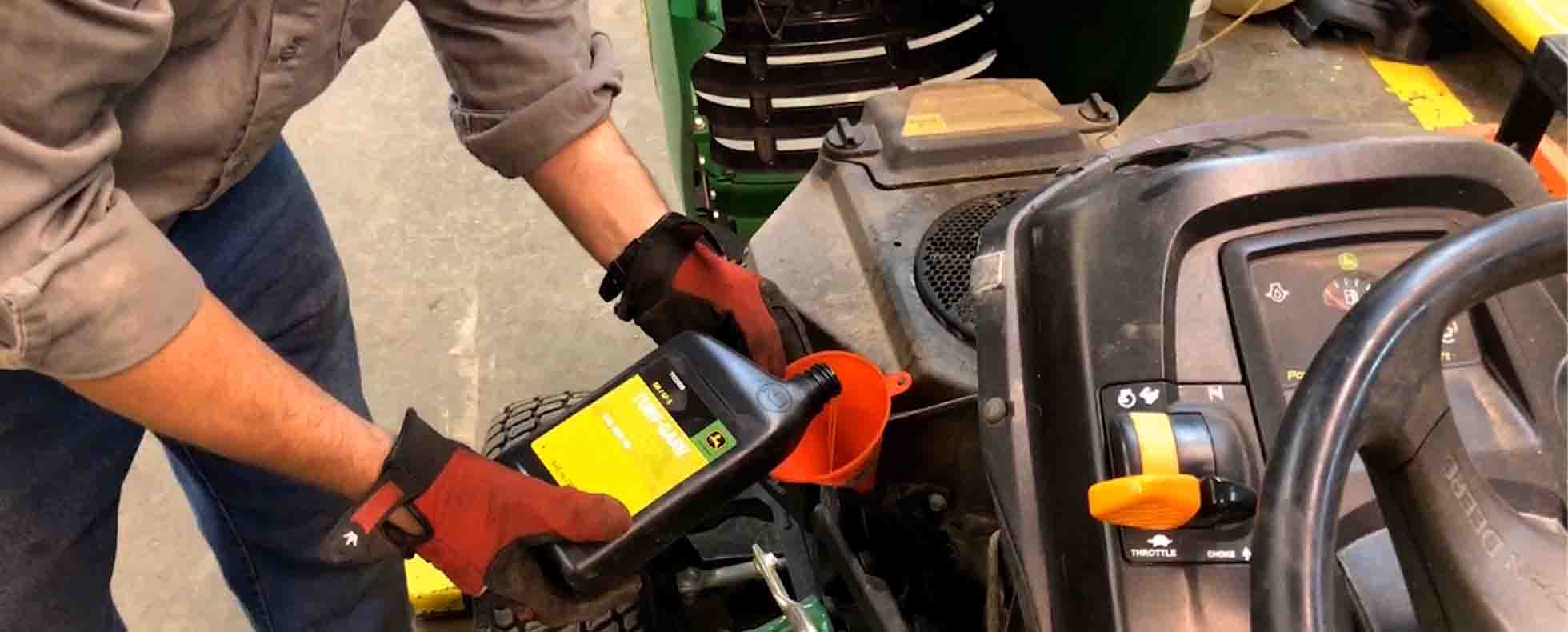
There’s nothing worse than unreliable equipment. A machine that doesn’t deliver top-quality results is a waste of precious time and effort and one that won’t start causes even more frustration.
Routine maintenance is one of the best ways to extend the life of equipment, and when it comes to lawn mowers, a little TLC goes a long way — especially to ensure a perfectly manicured lawn.
Our lawn and land equipment experts have rounded up five easy maintenance tips to keep your John Deere mower ready to run for years to come.
Note: Always consult the operator’s manual for specifics to your machine, like proper oil type and filter. Before proceeding with any maintenance, make sure to wear the appropriate safety gear, park the mower on a flat, level surface and double-check the engine is off and cool. For more information on proper lawn mower maintenance, visit your local RDO Equipment Co. store.
Clear the Air
Lawn mowers kick up a lot of dirt and debris, and a dirty air filter does more than hamper a mower’s performance – it creates an inefficient operation that wastes fuel. They can also cause permanent engine damage if they allow dirt and other debris to enter it.
Typically, air filters should be replaced once per year. For those who maintain large properties, mow commercially or operate in dusty conditions, the filter may need replacement more often.
To change the filter, clear away any debris from the air intake area and remove the paper element and foam pre-cleaner. Wash the foam pre-cleaner in a bucket of warm, soapy water. Rinse, squeeze out excess water and allow to dry on a clean towel. Once dry, replace the pre-cleaner, insert a new, clean air filter and close the cover.
A Fresh Fuel Filter
Fuel filters keep potentially harmful particles from entering and damaging the engine, and aids in efficient fuel consumption.
When it’s time to change a fuel filter, start by placing a drain pan under it. Be sure to note the arrow on the existing fuel filter and the direction it’s pointing — it’s crucial the new filter is attached so that the arrow is pointing in the same direction.
First, inspect the fuel filter and connecting hoses for wear or cracks. Loosen the hose clamps and move them away from the filter. Disconnect the hoses from the old filter and quickly reattach the new filter making sure it’s facing the correct way. Finally, reposition the hose clamps and ensure the filter is secure.
It’s a good idea to start the mower and let the engine run for a few minutes while quickly checking for any leaks. And don’t forget to properly dispose of the fuel filter, spilled fuel and any fuel-soaked towels.
Oil Toil
While engine oil should be checked prior to every use, it only needs to be changed annually or as recommended in your owner’s manual.
To change engine oil, start by placing a drain pan under the oil plug and loosen the dipstick and drain the oil. Once the oil has all drained out, use an oil filter wrench to remove the oil filter and replace it with the new filter. Be sure to apply a small amount of oil to the rubber sealing ring of the new filter. This will ensure a snug fit without damaging the rubber ring. Replace the oil plug, wipe down and clean up the area and replace the engine oil with a fresh fill and finally, replace the dipstick.
Run the engine for a minute, then shut it off. While the engine is cooling off, clean up any spilled oil and dispose of the old oil in a proper manner. (Check with local regulations and look for recycling options in the area.)
When the engine is cooled, check the oil level. Overfilling can damage the spark plug and lead to engine start issues so be sure the oil level is at an appropriate amount.
Individuals who use their mowers more frequently than the average homeowner or those who mow in dusty environments should consider changing their oil more frequently. It's important to note that new mowers undergo an initial 'break-in' period, requiring an engine oil change after the first 8 hours of operation.
Keep That Spark
If the mower engine is experiencing hard starts, running unevenly or misfiring under load, the spark plug may be the culprit, and identifying and changing a dirty or damaged spark plug is easy.
Disconnect the spark plug wire and use the spark plug socket to turn it counterclockwise, then remove it.
Use the spark plug socket to set the gap distance as specified in the operator’s manual. Tighten the new spark plug in place, then reattach the spark plug wire and start the engine
Occasionally, a spark plug may just be a dud. We recommend testing the spark plugs after replacing
Hit the Deck
To ensure good airflow, lift and quality of cut, the mower’s deck needs periodic maintenance.
Start by removing the mower deck as instructed in the owner’s manual and clean it of any excess debris.
Inspect the drive belt for worn or cracked areas and replace if needed. Next, remove and check the blade, looking for any signs of damage or excessive wear — depending on the condition, a blade can be replaced or may just need to be sharpened.
Prior to installing the new or sharpened blade, take one final opportunity to remove any buildup of dirt and debris.
It may sound time-consuming or complicated, but basic maintenance is one of the easiest, most cost-effective and all-around best investments you can make in your lawn mower.
With a little simple, routine care, your mower will pay you back with years of dependable operation and beautifully cut grass.